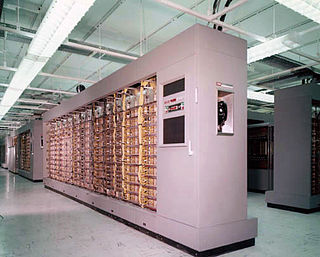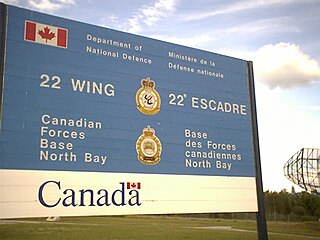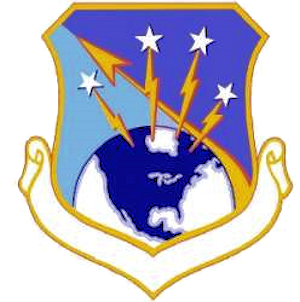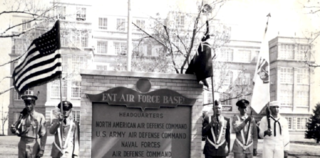Related Research Articles

The Semi-Automatic Ground Environment (SAGE) was a system of large computers and associated networking equipment that coordinated data from many radar sites and processed it to produce a single unified image of the airspace over a wide area. SAGE directed and controlled the NORAD response to a possible Soviet air attack, operating in this role from the late 1950s into the 1980s. Its enormous computers and huge displays remain a part of cold war lore, and after decommissioning were common props in movies such as Dr. Strangelove and Colossus, and on science fiction TV series such as The Time Tunnel.

The AN/FSQ-7 Combat Direction Central, referred to as the Q7 for short, was a computerized command and control system for Cold War ground-controlled interception used in the USAF Semi-Automatic Ground Environment (SAGE) air defense network.

Aerospace Defense Command was a major command of the United States Air Force, responsible for continental air defense. It was activated in 1968 and disbanded in 1980. Its predecessor, Air Defense Command, was established in 1946, briefly inactivated in 1950, reactivated in 1951, and then redesignated Aerospace rather than Air in 1968. Its mission was to provide air defense of the Continental United States (CONUS). It directly controlled all active measures, and was tasked to coordinate all passive means of air defense.

The AN/FSQ-32 SAGE Solid State Computer was a planned military computer central for deployment to Super Combat Centers in nuclear bunkers and to some above-ground military installations. In 1958, Air Defense Command planned to acquire 13 Q-32 centrals for several Air Divisions/Sectors.

The 26th Air Division is an inactive United States Air Force organization. Its last assignment was with Air Defense Tactical Air Command, assigned to First Air Force, being stationed at March Air Force Base, California. It was inactivated on 30 September 1990.

North Truro Air Force Station (AFS) is a closed United States Air Force General Surveillance Radar station. It is located 2.2 mi (3.5 km) east of North Truro, Massachusetts.

The Boston Air Defense Sector (BADS) is an inactive United States Air Force Air Defense Command (ADC) organization. Its last assignment was with the ADC 26th Air Division at Hancock Field, New York.

The San Francisco Air Defense Sector (SFADS) is an inactive United States Air Force organization. Its last assignment was with the 28th Air Division, being stationed at Beale Air Force Base, California.

The Phoenix Air Defense Sector (PhADS) is an inactive United States Air Force organization. Its last assignment was with the Air Defense Command 28th Air Division, being stationed at Luke Air Force Base, Arizona. It was inactivated on 1 April 1966

The Minot Air Defense Sector (MADS) is an inactive United States Air Force organization. Its last assignment was with the Air Defense Command 29th Air Division, being stationed at Minot Air Force Base, North Dakota. It was inactivated on 1 December 1963
The AN/FSQ-8 Combat Control Central was a United States Air Force computerized command and control system. Several of the centrals were used in the Semi-Automatic Ground Environment (SAGE) air defense network for Cold War ground-controlled interception to give "each combat center the capability to coordinate defense for the whole nation". Each AN/FSQ-8 was a smaller variant of the AN/FSQ-7 Combat Direction Central with less equipment since the Q8 received processed air defense data from AN/FSQ-7 centrals at Direction Centers. The AN/FSQ-8 centrals were housed in eight 3-story SAGE Combat Center (SCC) buildings similar to the Direction Center building and the Q8s allowed "supervision of the several sectors within the division." The Combat Centers "forwarded the divisional air defense status to" NORAD.
Backup Interceptor Control was the Electronic Systems Division 416M System to backup the SAGE 416L System in the United States and Canada. BUIC deployed Cold War command, control, and coordination systems to SAGE radar stations to create dispersed NORAD Control Centers.
The Burroughs AN/FST-2 Coordinate Data Transmitting Set (CDTS) was a Cold War military computer system at SAGE radar stations for displaying aircraft tracks and converting them for digital transmission to IBM AN/FSQ-7 Combat Direction Centrals at air defense data centers. Developed by the Great Valley Research Laboratory of the Burroughs Corporation as part of the Electronic Systems Division's 416L network of computers, 134 CDTSs were deployed. Each was to "process the raw radar data, antenna position information, and IFF data, and send it over voice grade toll phone lines" at ~1200 baud with 1/4 mile precision. The transmissions were received as "Long Range Radar Input" at SAGE Direction Centers, which performed the aircraft control and warning operations and provided command information to Command Centers which forwarded data to the NORAD command center in Colorado. The AN/FST-2A included 2 vacuum tube computers and accepted 14 input signals.
A command, control, and coordination system (CCCS) was a Cold War computer system for United States command posts to use a single location to coordinate multiple units' ground-controlled interception and may refer to:
Ground Air Transmit Receive (GATR) control sites were the radio stations of a Burroughs 416L SAGE Defense System of the United States Air Force.
The GE AN/GPA-37 Course Directing Group was a USAF Cold War air defense command, control, and coordination system for weapons direction. During Air Defense Command's "Control Capability Improvement Program" to improve command guidance of manned aircraft, the AN/GPA-37 was "developed by the General Electric Heavy Military Electronic Equipment Department at Syracuse in conjunction with...Rome Air Development Center and the Electronics Research Laboratories of Columbia University." Used to process radar data, the system was to "track a potential enemy aircraft and direct intercepters [sic] into a position from which they can make their automatic firing runs", the system included the:
An Air Defense Direction Center (ADDC) was a type of United States command post for assessing Cold War radar tracks, assigning height requests to available height-finder radars, and for "Weapons Direction": coordinating command guidance of aircraft from more than 1 site for ground-controlled interception. As with the World War II Aircraft Warning Service CONUS defense network, a "manual air defense system" was used through the 1950s Along with 182 radar stations at "the end of 1957, ADC operated … 17 control centers", and the Ground Observation Corps was TBD on TBD. With the formation of NORAD, several types of ADDCs were planned by Air Defense Command:
NORAD Control Centers (NCCs) were Cold War "joint direction centers" for command, control, and coordination of ground-controlled interception by both USAF Air Defense Command (ADC) and Army Air Defense Command (ARADCOM). The Joint Manual Steering Group was "formed by the Army and Air Force in July 1957 to support…collocation" of USAF Air Defense Direction Centers and Army Air Defense Command Posts, which began after a January 28, 1958, ADC/ARADCOM meeting with NORAD to "collocate the Fairchild-Geiger facilities" Army contracts for 5 NCCs had been let by August 17, 1958, after 1956 DoD approval for collocation of interim "pre-SAGE semiautomatic intercept systems" and radar squadrons at 10 planned Army Missile Master AADCPs

The ITT 465L Strategic Air Command Control System was a Cold War "Big L" network of computer and communication systems for command and control of Strategic Air Command "combat aircraft, refueling tankers, [and] ballistic missiles". International Telephone and Telegraph was the prime contractor for Project 465, and SACCS had "Cross Tell Links" between command posts at Offutt AFB, March AFB, & Barksdale AFB (SACCS also communicated with the Cheyenne Mountain Complex and Air Force command posts. The 465L System included IBM AN/FSQ-31 SAC Data Processing Systems, Remote and Simplex Remote Communication Systems, SAC Network Control Office, "4-wire, Schedule 4, Type 4B alternate voice-data operation", and one-way communication with "ICBM launch control centers" In addition to IBM for the "Super SAGE type computers", another of the 6 direct subcontractors was AT&T,

Continental Air Defense Command (CONAD) was a Unified Combatant Command of the United States Department of Defense, tasked with air defense for the Continental United States. It comprised Army, Air Force, and Navy components. It included Army Project Nike missiles anti-aircraft defenses and USAF interceptors. The primary purpose of continental air defense during the CONAD period was to provide sufficient attack warning of a Soviet bomber air raid to ensure Strategic Air Command could launch a counterattack without being destroyed. CONAD controlled nuclear air defense weapons such as the 10 kiloton W-40 nuclear warhead on the CIM-10B BOMARC. The command was disestablished in 1975, and Aerospace Defense Command became the major U.S. component of North American Air Defense Command (NORAD).
References
- ↑ Schaffel, Kenneth (1991). Emerging Shield: The Air Force and the Evolution of Continental Air Defense 1945-1960 (45MB pdf). General Histories (Report). Office of Air Force History. ISBN 0-912799-60-9 . Retrieved 2011-09-26.
A SAGE component, a 64 x 64 [4K] magnetic core memory ... SAGE direction center. This installation is located at Stewart Air Force Base in New York state. ...[Hancock Field] combined direction-combat center was located at Syracuse, New York.
[captions of p. 198, 208, & 265 photos] NOTE: Schaffel's history uses the same name as "The Emerging Shield: The Air Defense Ground Environment," Air University Quarterly Review 8, no. 2 (spring 1956). - ↑ DeWerth, John P. ...Sage Memories (personal notes) (Report). SMECC.org. Retrieved 2012-04-03.
Senior Director's keyed console...fire button
"[AN/GSA-51]". SMECC.org.BUIC ... Burroughs...D825 ... McChord AFB...August 1983
"Phoenix Air Defense Sector". SMECC.org.Luke AFB...February 1984
- 1 2 Winkler, David F; Webster, Julie L (June 1997). Searching the Skies: The Legacy of the United States Cold War Defense Radar Program (PDF) (Report). U.S. Army Construction Engineering Research Laboratories. Archived from the original on December 1, 2012. Retrieved 2012-03-26.
"BUIC II radar sites would be capable of incorporating data feeds from other radar sectors directly onto their radar screens.
- ↑ Hellige, Hans Dieter (February 1993). Actors, Visions and Developments in the History of Computer Communications (PDF) (Report). "Work and Technology" Research Centre. Archived from the original (PDF) on 2012-11-16. Retrieved 2012-04-02.
- ↑ Page, Thomas E. (June 16, 2009). "IBM SAGE" (anecdotal message post). Ed-Thelen.org. Retrieved 2013-02-21.
A number of Super-SAGE Combat Centers (AN/FSQ-32) were planned, but none was built.
(T. E. Page cites: "Shield of Faith" by Bruce Briggs (Simon and Schuster, 1988.) - 1 2 Anderson, James P.; Hoffman, Samuel A.; Shifman, Joseph; Williams, Robert J. (1962). "D825 - a multiple-computer system for command & control". Proceedings of the December 4-6, 1962, fall joint computer conference on - AFIPS '62 (Fall). pp. 86–96. doi:10.1145/1461518.1461527. S2CID 1186864.
- 1 2 "BUIC Fact Sheet". Burroughs Corporation. Archived from the original on July 29, 2003. Retrieved 28 February 2013.
- ↑ Thompson, Rankin N. & Wilkinson, John A. (1963). "The D825 automatic operating and scheduling program". Proceedings of the May 21-23, 1963, spring joint computer conference on - AFIPS '63 (Spring). AFIPS '63 (Spring). pp. 41––49. doi:10.1145/1461551.1461558. S2CID 16688308.